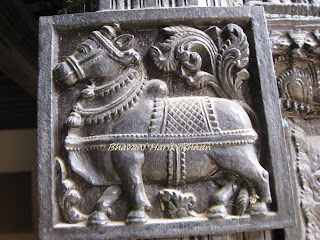Paintings and Yester Year's Architecture
I've created this blog as much for my own reference as for others. As a kid, I loved to draw. But over the years I've realised that all I can ever be is a copycat artist. So I strive to be a good copycat. I've picked up some techniques along the way. I use this blog to share them. At the moment I am particularly interested in Indian murals in general, Kerala mural paintings and Tanjore paintings in particular
Tuesday, 24 March 2020
Tuesday, 7 October 2014
Kerala Mural Painting : Free Online Class - Session V
Preparing the Canvas for the Painting
The canvas I had ordered was delivered to me yesterday. Here it is. So, let's get started. (I am not done with the design elements yet. But we'll take it up again later.)
Priming the Canvas
The canvas I had ordered was delivered to me yesterday. Here it is. So, let's get started. (I am not done with the design elements yet. But we'll take it up again later.)
Priming the Canvas
- Before you open the can of Acrylic Distemper paint, check the use by date. If it is over 24 months old, return it and ask for a replacement. (Usually, the paint is good for about 3 years. I insist on < 24 months because, after this one project, there's no telling when you will use it again.)
- Mix 1-1.5 ladles of the paint with water in the ratio of 1:6 = paint:water. Mix thoroughly to ensure there are no lumps.
- The consistency is quite watery.
- Using the 2.5" synthetic hair brush and vertical strokes apply first one coat of paint to the canvas. Don't use back strokes.
- If the grain of the canvas is still visible then, you're doing this right.
Are you wonderding what a grain refers to in this context?
Feel the canvas. It does not have a smooth texture. The direction of the weft and the warp threads that produce the weave lend the canvas this texture.
- Allow it to dry completely. Drying it in the sun could cause the paint to crackle. This is something that could happen either immediately or sometime in the future and we definitely want to avoid it. Therefore, it is better to wait patiently for it to dry in the shade (2-3 hours).
- If you are using an old brush for paining, chances are, some strands of hair get trapped on the canvas. Gently remove them with your fingernails after the paint is completly dry.
- Once it's dry, apply a second coat of paint to the canvas, this time, use horizontal strokes.
- Wait until it dries completely and using vertical strokes give it a third coat. Give it a day to dry completely.
Now. we are ready to transfer the design to the canvas.
Update - 25th Nov 2015
Why should you prime the canvas?
Links to Other Related Posts:
Update - 25th Nov 2015
Why should you prime the canvas?
- Priming prepares the canvas to receive the paint and in the case of oil paints, prevents the chemicals in the paint from damaging the canvas.
- However, priming with thick base coats can result in flaky base and damage the painting over a period of time.
- Therefore make sure, the acrylic distemper paint you use for priming is so dilute that it does not leave a visible residue on the canvas.
Links to Other Related Posts:
- Materials Required
- Ornaments for forearms and feet
- Ornaments for Upperarms, shoulders and ears
- Original Murals - Mahalakshmi, Gopikrishna, Siva
- Original Murals - Arthanareeshwar, Mahishasuramardini, Maha Vishnu
- Original Murals - Siva-Vishnu, Geometrical fillers, Siva-Parvathy
- Originals - Maha Vishnu, Natarajar, Krishna
- Originals - Govardhan, Sivalingam, Siva
- All sessions of Kerala Mural Painting Free Online Classes
Subscribe to:
Posts
(
Atom
)





